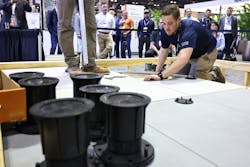The Ins and Outs of Pedestal Tile Systems
In any industry, and certainly with our industry, we generally don’t develop a standard until there’s a relatively consistent, proven track record of success. Pedestal tile systems have been around for some years, but we don’t yet have a standard. That being said, there are many best practices to adhere to.
Why Tile Pedestals?
Pedestal systems work by allowing water to flow through gauged porcelain tiles to a drainage substrate then away from the tile. The substrate can be concrete or a variety of roofing membranes such as PVC, EPDM, TPO, or torch-down asphalt.
Tile pedestals are an unbonded system, which provides many advantages for remodeling contractors.
First, with traditional bonding methods, moisture often leaves minerals and salts after it has dried. This white film is called efflorescence and can be hard to remove, but it’s common with both natural stone and porcelain when these products are bonded. A pedestal system removes this problem.
Next, it allows us to install tiles where it had not been recommended before, such as cold weather. Cold temperatures will often leave freeze-thaw damage.
Moreover, without mortar and grout, the tiles can be swapped out easily, mitigating dust and creating a smoother remodel.
RELATED: Diagnosing Cracked Concrete
Planning Tips
Installation of tile on a pedestal system means it’s not the typical three-day process. Instead, it takes careful planning and a crew to do the job.
Pedestal systems can be used on rooftops, on-grade and raised terraces, courtyards, pool decks, and amenity decks. They are often installed over pitched waterproofing assemblies. Before selecting the porcelain ideal for the setting, it’s important to keep the coefficient of friction in mind, as well as the wind requirements.
Because there are no standards for installation, adhere to the manufacturer’s recommendations. Not all gauged porcelain tiles can be used in pedestal systems. Some manufacturers require a backing layer on the tile, which depends on the application, depth, or height of the cavity beneath the paver.
3 Tile Pedestal Musts to Understand
Substrate compression: Except for a five-pedestal application, pedestals are installed on the corners of the pavers. This requires a minimum of 40 to 60 pounds per square inch, or as required by the manufacturer.
Slip sheet: Slip sheets are required when installing gauged porcelain over any membrane. Use the roof membrane or a compatible rubber sheet.
Containment: This is the most important criteria in a pedestal assembly. The tile must abut a wall curb or a type of restraint, then be supported at the edge.
This information will allow you to follow best practices when installing porcelain pavers on pedestal assemblies, but it’s not exhaustive. Refer to the manufacturer’s recommendations (many porcelain manufacturers recommend a specific pedestal brand).
Bart Bettiga has been the executive director of the National Tile Contractors Association since 2002 and has over 30 years of experience in the tile and stone industry.

